During the last two weeks in May of 2019, I visited South Korea for the very first time. I spent the first week traveling with other travel bloggers and the Korea Tourism Organization, who gave us our first taste of the Korean dishes you must eat. During the second week, my friend Sam and I did some more in-depth explorations of Seoul, Busan, and Daegu.

Along the way, we tried dozens of remarkable Korean dishes. I went from having very limited knowledge of what Korean food was, to having Korean cuisine skyrocket up my list of favorite food cultures in the world. From the tantalizing flavors of Korean barbecue to the traditional dishes eaten by Buddhist monks to the expansive world of Korean street food, this country is a foodie paradise.

I wish I could include every Korean dish I loved in this list, but I decided to narrow it down to the ones that truly teased my palate and enchanted my taste buds. The ones that made my mouth water just by smelling them. These are the 25 Korean dishes you must eat!

One of the most popular street foods in South Korea is tteok-bokki. They’re dense, chewy, cylindrical rice cakes that are bathed in a spicy, rich red chili sauce called gochujang. I first tried this amazing treat at Ameyoko Market in Tokyo, but the South Korean version blew me away. You can get it almost anywhere, including street food markets, restaurants, buffets, and even baseball stadium concessions. But the best place to try it is Tongin Market in Seoul.

The tteok-bokki there was everything I needed it to be: chewy, spicy, and oily. These rice cakes weren’t swimming in gochujang sauce like most of the other varieties I’d tried around the country. Even so, they still made my mouth water the moment I laid eyes on them. They’re one of the best Korean dishes you must eat and are a true treat for your taste buds!
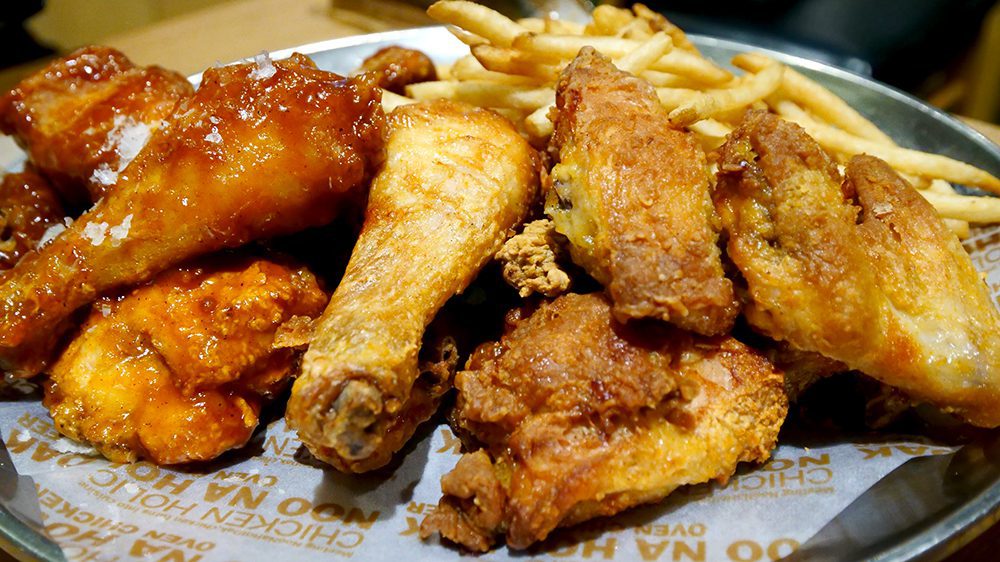
I’ll be honest. Americans like to think they make the best fried chicken in the world. But after visiting South Korea, our fast-food chicken chains don’t come even close to what the Koreans are doing. The chicken there is freshly made. You can actually taste that it has never been frozen and is as natural as you can get. And the best part is, you’d be hard-pressed to find bad fried chicken in the country. Every variety I had was out of this world!

One of my absolute favorites is the dakgangjeong you can find at Tongin Market. Dakgangjeong is basically a much tastier version of popcorn chicken. It’s covered in a thick sweet and sour glaze and is some of the freshest-tasting chicken I’ve ever had. It’s an incredible food experience and is one of the top Korean dishes you must eat, period.
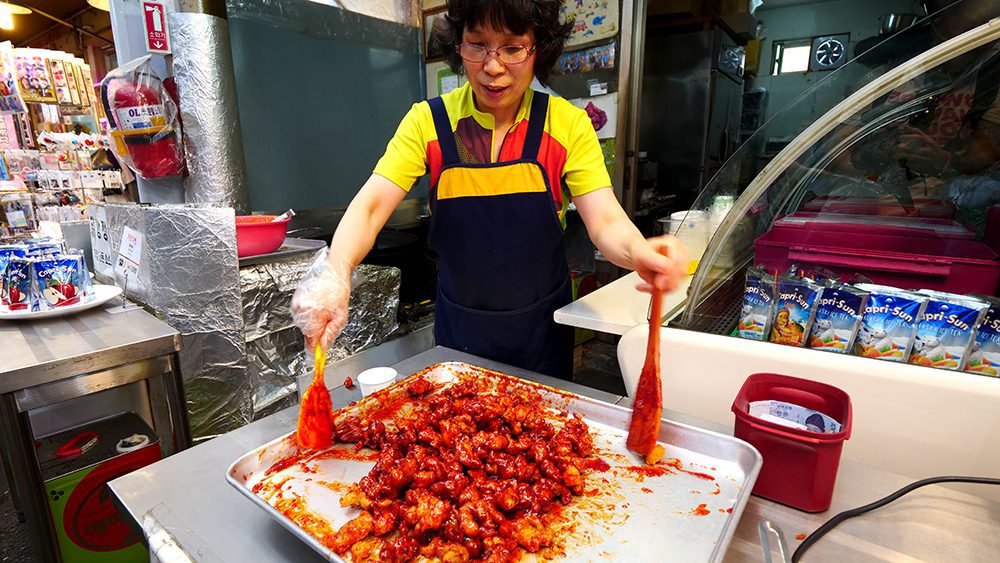
Another spot you have to hit up for amazing Korean fried chicken is Oven Chicken and Beer in Seoul. There, you must try their regular fried chicken. It has that remarkable, fresh taste I mentioned earlier. It’s crispy on the outside and juicy on the inside, exactly the way fried chicken should be!
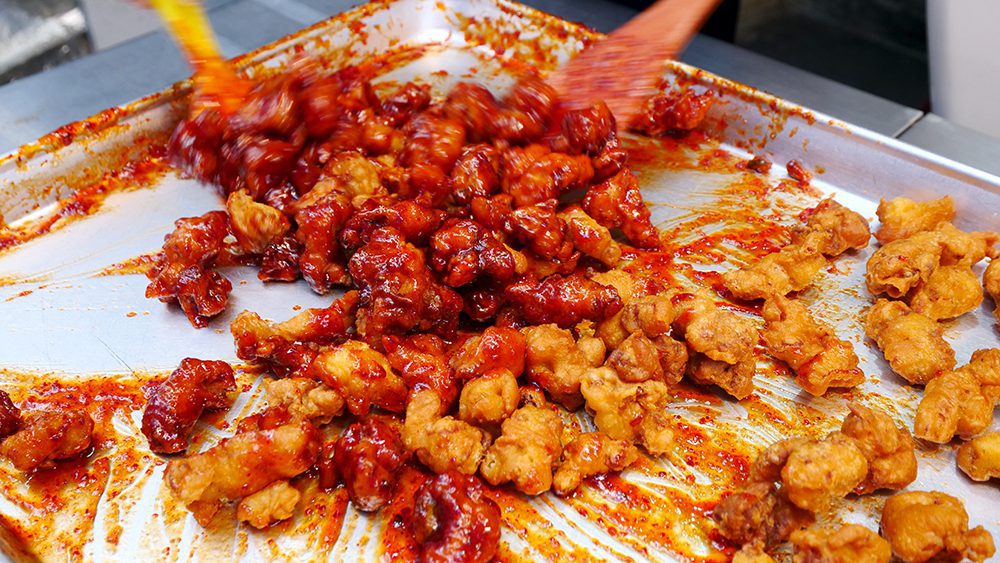
They also make a version that’s slathered in a sweet and spicy sauce that brought to mind Chinese sweet and sour chicken, except with a nice tanginess. Their soy sauce chicken, which is coated in the dark brown sauce, is also sensational!

I love a good dumpling. I also love kimchi, the spicy, fermented cabbage dish that is the national dish of South Korea. So, naturally, when I found out there’s a dish that combines the two, I knew I was in for a divine gastronomical experience. For this dish, the kimchi mandu, you should head over to Namdaemu Market.
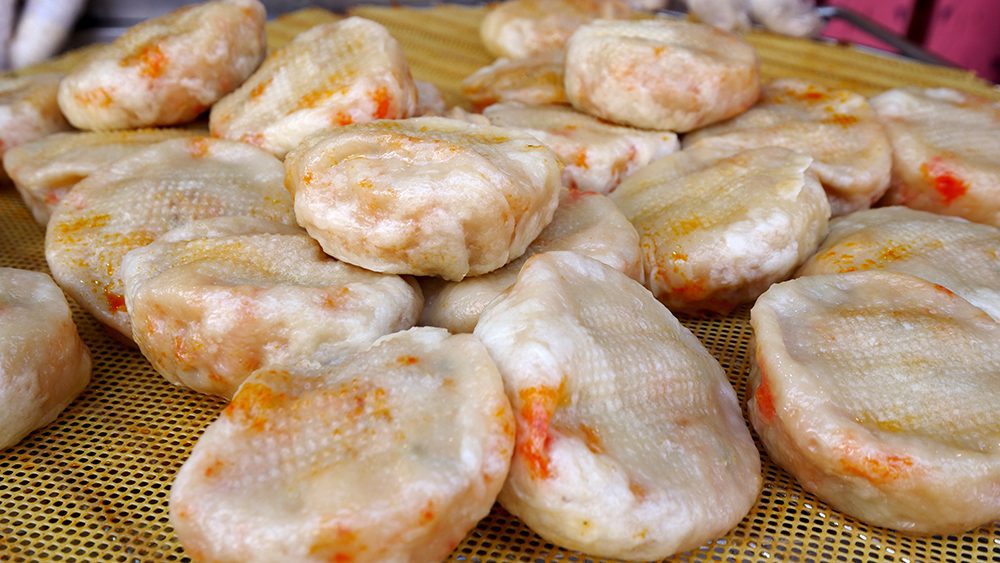
This scrumptious, reddish mandu (the Korean word for dumpling) was stuffed with spicy kimchi, delicate glass noodles, and tender pork. I was in heaven after just one bite. The sour, spicy kimchi with the fatty pork and fragile noodles was a treat for my palate like no other. I’m salivating just thinking about it!

Just don’t dive in immediately, because these pockets of Korean goodness are served piping hot and can easily scald your tongue. Give them a moment to cool down and then go to town on them. You (and the inside of your mouth) will thank me later! You can get five mandu for $4,000 won, or $3.30 USD, which makes this Korean dish you must eat, a total steal!

I’ve mentioned on my blog that I don’t really have much of a sweet tooth. Sweets are nice, but I’ll almost always choose something spicy or savory over anything sugary. Except honey. If you want me to eat your sweet, make sure it has honey and I’m all over it. That’s exactly what happened when I found the honey-and-cream stuffed pastry called hotteok at Tongin Market.

It’s served to you straight out of the oil, so it’s super greasy and needs a few minutes to cool down. Give it a few minutes to cool down and take a nibble of the crispy, golden-brown exterior. Once you’re sure the inside is no longer molten lava, take a bigger bite. Mine had so much filling that it burst, sending hot honey and cream oozing out the other side. It’s messy and decadent and is easily one of the top Korean dishes you must eat in Seoul!

If you’re an occasional watcher of my travel/food vlogs on YouTube, you probably know that I love to indulge in fatty, creamy, decadent cultural dishes when I travel. But you may not know that I also love the flavors and crunch of fresh vegetables. Enter gimbap.

Gimbap is the Korean word for hand rolls, which contain rice and lots of fresh vegetables wrapped in crispy seaweed. Some varieties will also contain an animal protein like pork or fish. Like nearly all of the Korean dishes you must eat, they’re fresh and extremely tasty.
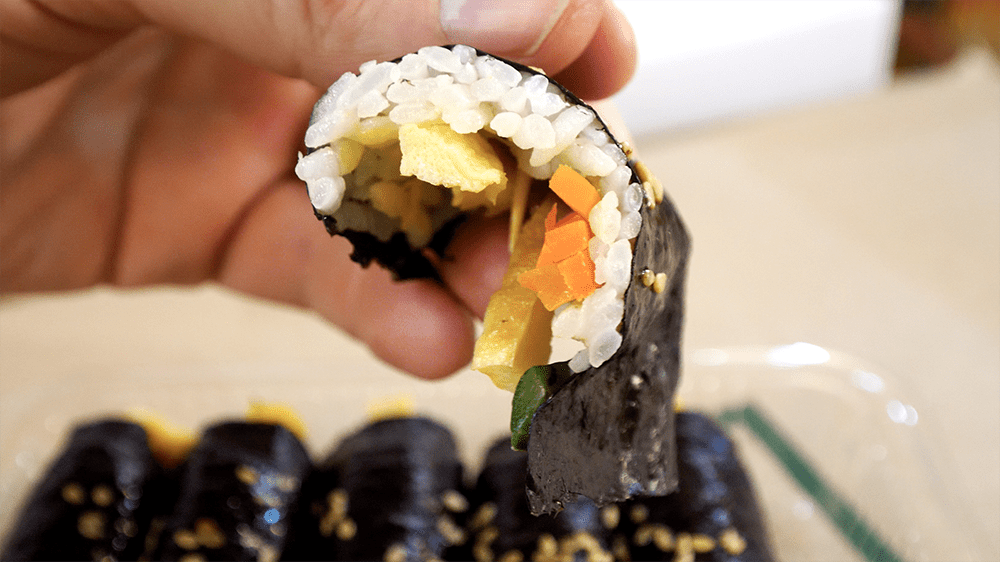
In the indoor, underground section of Namdaemun Market, you’ll find a gimbap that contains seaweed, rice, carrot, cucumber, and radish. It has sesame seeds on the outside, which add a nice nuttiness that goes well with the fresh, crisp vegetables and slightly briny seaweed.

This gimbap is served with soy sauce mixed with a very hot wasabi that gives you a quick burst of heat that dissipates quickly. Best of all, it only costs 2,000 won, or $1.65 USD, which makes it a tasty, filling, and inexpensive snack!
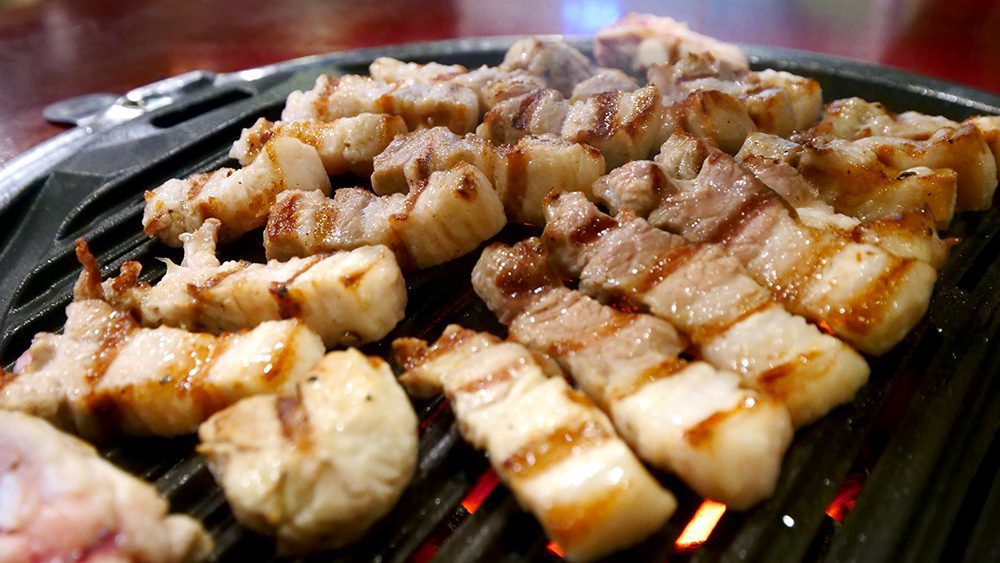
Just hours after I landed in Seoul after a roughly day-long journey from Miami, my good friend Sam took me to a restaurant selling grilled Korean pork belly. I am a huge pork belly fan and have eaten varieties of it all over the world. This kind blew my socks off! It’s called samgyeopsal and it delivers the crispiness, fattiness, and juiciness that all good pork belly is known for.

Samgyeopsal is a form of Korean barbecue, so it’s grilled right at your table. After it has been cooking for a while, your waiter will cut the pork belly into strips, which you wrap in a piece of lettuce with red pepper paste and garlic. This tasty pork belly package is meant to be eaten in one delicious bite and is truly life-changing. After one bite, you’ll understand why it’s one of the Korean dishes you must eat!
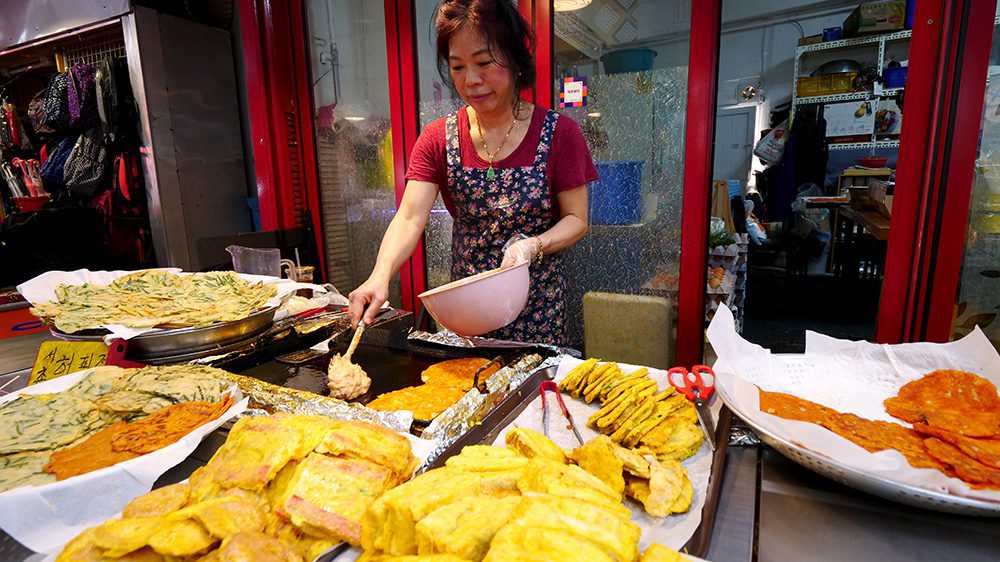
I’ve already professed my love for kimchi, the delicious, spicy fermented cabbage that I can’t get enough of. Combine it with another of my favorite foods, pancakes, and I’m all in! This amazing mixture can be tasted by trying another of the top Korean dishes you must eat, kimchi-jeon, which I discovered at Tongin Market.

The spicy, moist kimchi is phenomenal in this dish. The pancake itself is made of a minimal amount of batter and allows the kimchi to be the star of the dish. The small amount of batter gives the dish a palatable crunch and takes it to the next level. I love the savory pancake dishes you’ll find around the Far East and this one is easily my favorite!

One of the highlights of my time in Seoul was the cooking class I took early in my trip. I learned to make two incredible dishes, including a delicious, spicy seafood stew called sundubu jjigae. The dish is made up of shrimp, cucumber, onions, leeks, tofu, and squid. And trust me, I’m no cook! So if I can make it, so can you!

This stew is nothing short of fantastic. It had just the right amount of spice while still being bright and fresh because of the vegetables. The shrimp and squid added a briny flavor and a new layer of texture, while the silky tofu added a smoothness that absorbed all of the rich flavors in the pot. It’s one of my favorite Korean dishes you must eat in Seoul, and I’m not just saying that because I made it!
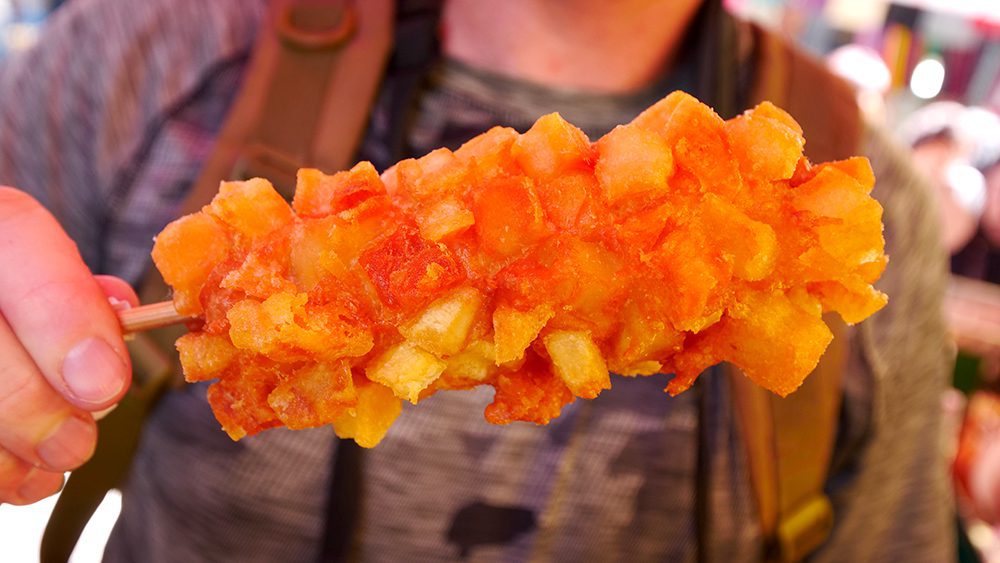
Any market that has been around since 1414 has to be good in order for it to stand the test of time. After visiting the historic Namdaemun Market, I can attest that some of the best Korean dishes you must eat can be found among its 10,000 stalls, including the potato-crusted hot dog on a stick.

This dish is exactly what it sounds like. The potato exterior is crunchy and salty like a good French fry, and is also quite spicy, while the hot dog inside is juicy and moist. Add some new layers of flavor with the four sauces provided. There’s a spicy sauce with a tangy kick and a milder, sweeter sauce. It’s convenient and is pretty tasty!

With so many exciting and flavorful foods available everywhere in Seoul, it’s easy to overlook more traditional cuisine like Buddhist monastic food. To try a large spread of the types of food served at Buddhist monasteries around the country, stop by Balwoo Gongyang Restaurant.

There, you’ll learn that Korean Buddhist food is straight to the point and is made with simple, fresh ingredients. For example, the appetizer course consisted of a lovely, oatmeal-like rice porridge with peanuts, a sour kimchi soup, and a juicy lychee.

The next course was light on flavor ad spices and consisted of bean curd, a kimchi cucumber, mung bean jelly with lotus fruit, and a green leaf. Two of my favorite dishes in the following course were a plantain-like fruit with a sweet and sour glaze and a tasty, creamy noodle dish with mushrooms.

Other fantastic Buddhist monastic dishes at Balwoo Gongyang included a tasty potato and onion pancake and a vegetable pancake. You also can’t leave without trying the spicy bamboo, the fermented soybean paste soup, and spicy mushrooms.
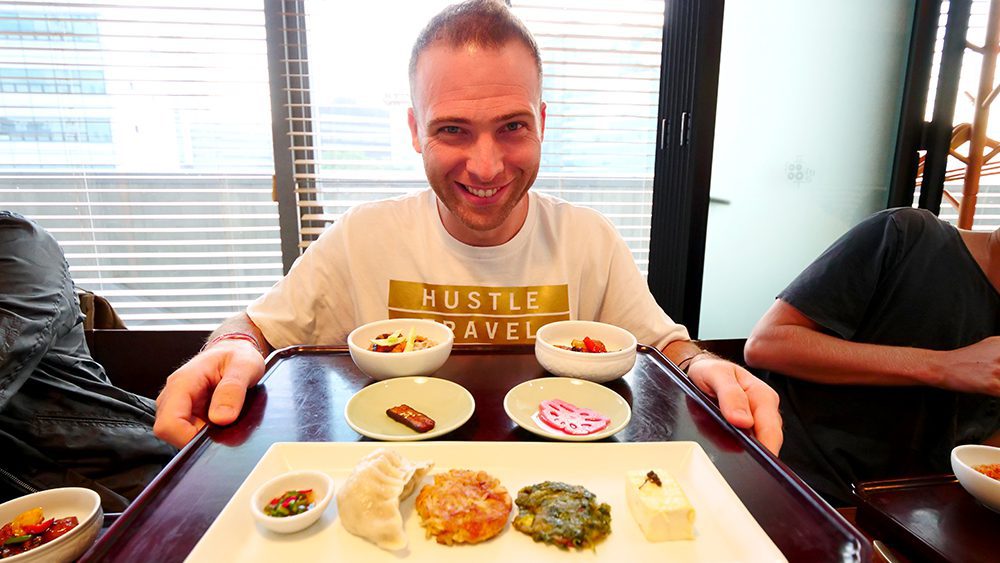
The dessert course is made up of dried kiwi slices and red tea. I’ll admit, the tea had no flavor, but the dried kiwi was phenomenal. I wish I could have had more of it!

This meal definitely contains some outright delicious dishes, as well as others that might be an acquired taste for some. But if you want to really dive into the Korean dishes you must eat, and get a taste of everything the local cuisine has to offer, you have to try it!

When I travel through India, something I always have to have is sugarcane juice, which is a refreshing beverage you can get right on the street in most major cities. The closest equivalent I found in South Korea is sikhye, a sweet, refreshing, rice-based drink that contains has bits of rice grains floating in it!
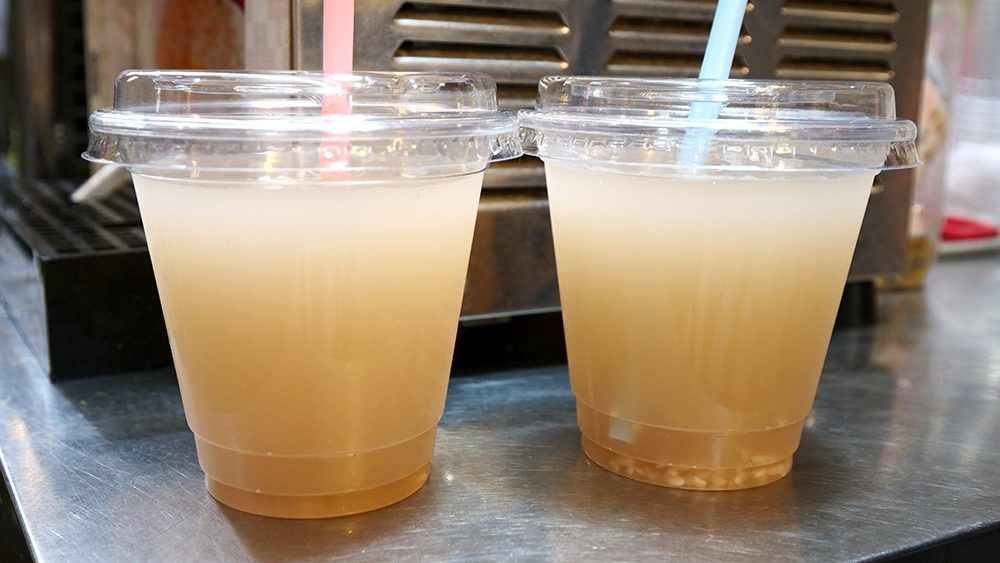
I visited Seoul in late May, right on the cusp of summer, so the weather was hot and muggy nearly every day. After sweating like crazy during most of my Tongin Market visit, the sikhye cooled me down and hydrated me. It was exactly what I needed to keep going and I highly recommend it!

Rice cakes are all the rage in eastern Asian countries like South Korea and Japan. I talked about the delicious, savory tteok-bokki earlier, but you can also get some delightful sweet rice cakes in South Korea as well. Head over to Namdaemun Market, where you might be lucky enough to meet a nice woman selling two types of sweet rice cakes. One is green one and the other is white.

Both are spongy and dense, but the green one contained powdered peanut on the inside. I love peanut flavor, so the combination of sweet and nutty had my taste buds dancing. I admit I couldn’t really place the filling in the white rice cake. It was tasty, but I liked the green one better. Try them both to see which of these Korean dishes you must eat tastes better to you! They cost 1,000 won, or just $0.84 USD for four, so try two of each!

The other food I made during my Korean cooking class is a crispy, savory pancake called haemul pajeon. The pancake’s main ingredients are seafood and green onions, and also contains a batter made from flour, water, and salt. You cook it like a normal pancake and then add the spring onion, squid, and vegetables as it cooks. Some egg is also added to bind it together. Once it’s brown and crispy, it’s ready to be served.

The savory components of the haemul pajeon, including the onions and vegetables, add lightness and freshness. The seafood adds that briny taste from the deep, which works really well in the pancake. Eat it with some soy-vinegar-chili sauce for a boost of flavor and heat. It takes the pancake to a whole new level and makes it one of the Korean dishes you must eat, without question!

I’ll be real with you. Namdaemun Market isn’t the easiest market to navigate if you’re on the hunt for street food. The food stalls are few and far between and it can be frustrating when you’re hungry and all you see is retail everywhere you look. But keep going, because eventually, you should find the street food, including some amazing fried rice cakes.
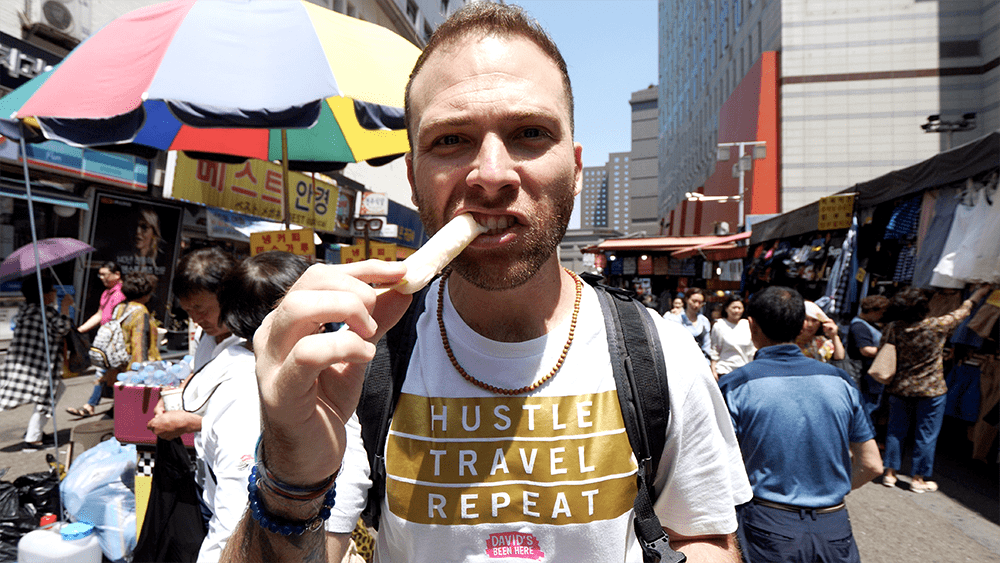
This polenta-like rice cake, called a tteok, was a bit tough on the outside and had a dense and chewy center. It’s fairly bland and could use some sauce to add more layers of flavor, but it’s actually not bad! In fact, it’s a nice, portable, and filling that will cost you less than $1 USD at just 1,000 won or $0.84 USD each!
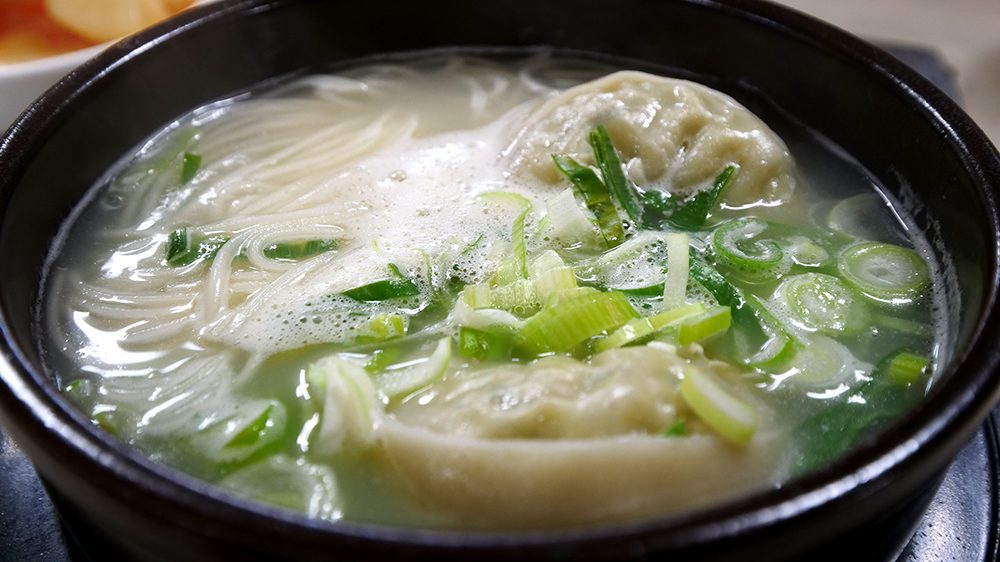
I mentioned my deep love of mandu earlier. These steamed dumplings are little pillows of perfection, and they’re downright magnificent when they’re floating in a Korean soup called manduguk. It’s made by cooking the dumplings in an eggy beef- or anchovy-based broth, which tastes similar to miso soup.

I wish I knew the name of the restaurant where I tried it, but it’s located down a tiny alley near Gyeongbokgung Palace. The miso-like flavor permeated the noodles and dumplings, which were bursting with hearty pieces of juicy pork. I also could not get enough of the mouthwatering, aromatic herbs inside the mandu, and the fresh, crunchy spring onions sprinkled throughout the broth.

I’m sure many people have seen footage of people eating squirming pieces of raw octopus. The footage alone is enough to make some people cringe, while those with more adventurous palates can’t wait to try it. You’ll have your chance at Tent #5 at the Taejongdae Clam Tents in Busan. This exotic feast is not for the faint of heart!

The octopus is the centerpiece of an entirely raw seafood feast. The spread consists of familiar items like clams, oysters, and mussels, as well as more exotic offerings I couldn’t identify. And yes, at the center of the platter is the octopus, so freshly killed that its tentacles writhe around like it’s trying to escape back into the sea.

The clams and mussels are fresh, succulent, and delicious, especially with the spicy ketchup-like sauce that’s served on the side. They were my favorite part of the meal. Some of the unknown items were quite tasty, while others were so tough I almost broke a tooth trying to chew them. Be careful!
You sometimes hear about how still-squirming octopus can be dangerous to eat, and after this meal, I understand why. Even in death, the octopus’ suction cups still work. It’s a little shocking when you realize that a tentacle has latched onto your tongue or the inside of your cheeks, but it would be a whole other story if it grabbed the inside of your esophagus because you didn’t chew it well enough.
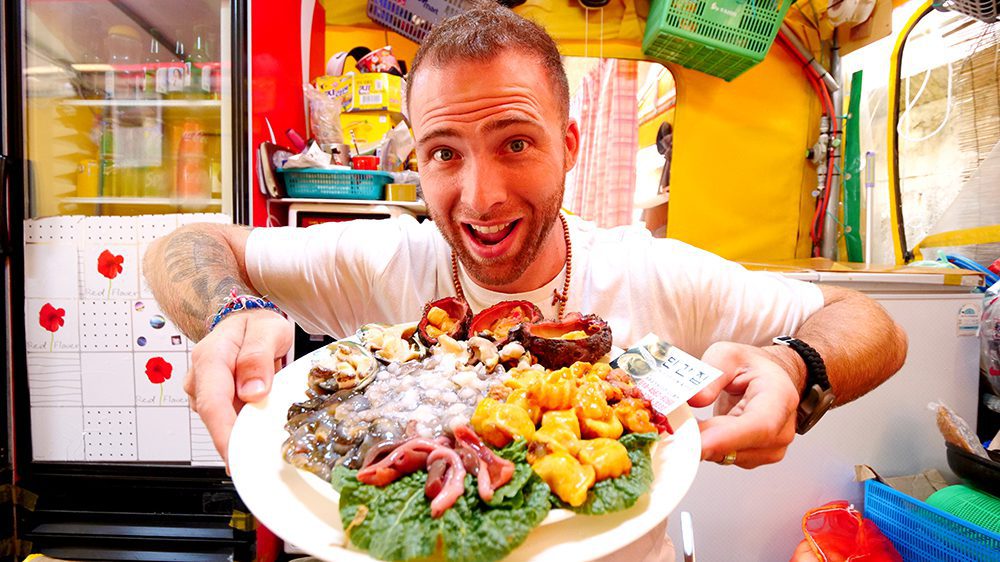
Because of that, this is not a dish you can eat quickly. You kind of have to fight with it. And while it makes for an interesting story to tell afterward, the actual process of eating it borders on unpleasant. Still, if you’re a foodie traveling through the country, this is easily one of the top Korean dishes you must eat. It’s way too tempting to pass up! Just keep chewing!
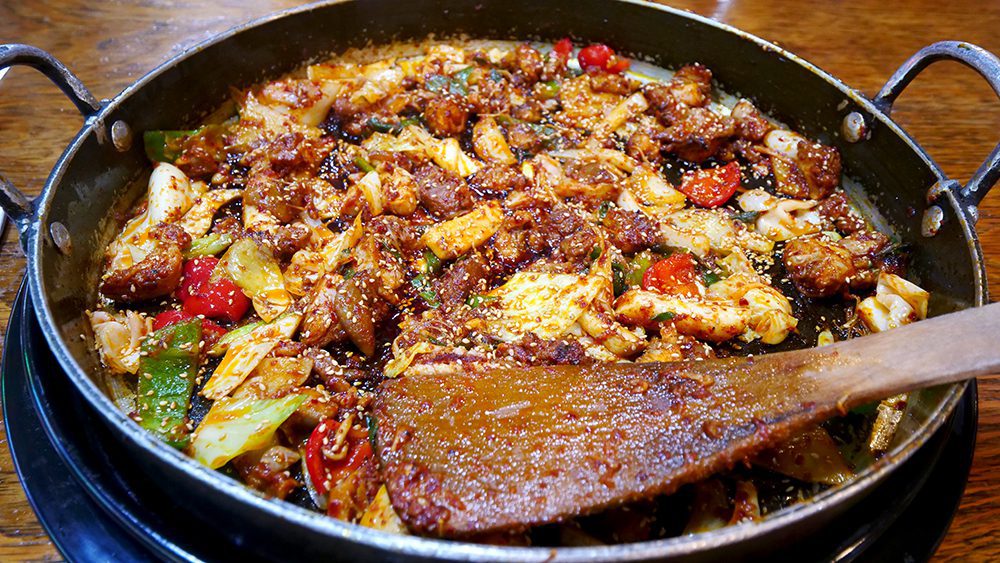
During your time in Busan, you’d be remiss if you didn’t have some dakgalbi in the bright and vibrant Bujeon-dong area. Dakgalbi is a sensational barbecued chicken dish with cabbage, green peppers, spring onion, rice cakes, red peppers, and gochujang sauce.

It’s tender and flavorful and is honestly one of my favorite chicken dishes of all-time. But it doesn’t end there. After you eat roughly half of it, you can have your waiter come back with an order of fried rice with chicken and cheese.
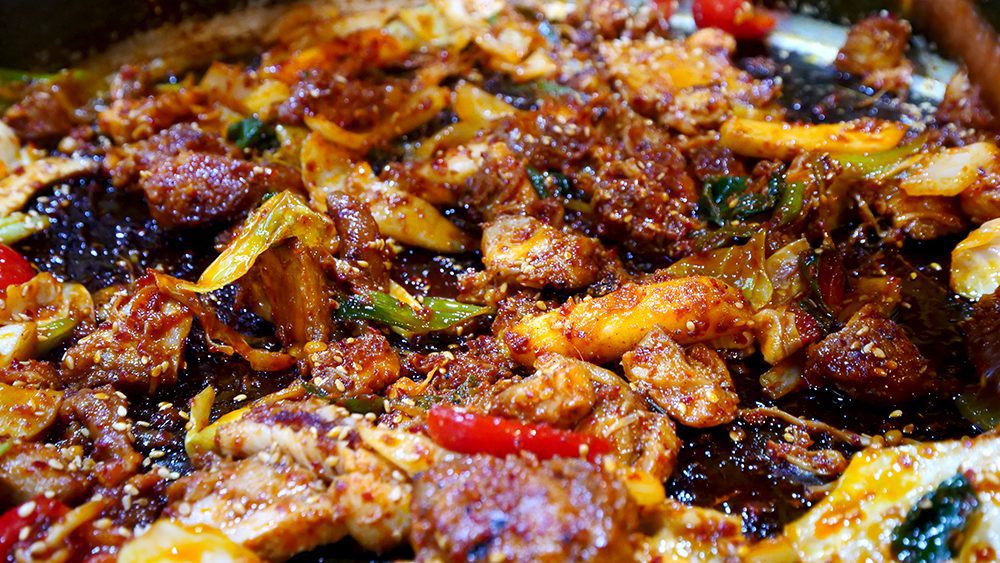
They’ll mix it with the dakgalbi and stir-fry it up to create a bokkeumbap. The cheesy, crispy rice, chicken, and vegetable mixture is greasy and everything I imagine Korean food heaven would be. You can’t afford to miss it!

During my time in Busan, I took a quick day trip up to the historical city of Gyeongju, which is home to Korea’s most fascinating historical and archaeological sites. While in Gyeongju, I highly recommend trying the local Korean Chinese food at Eohyang-Won Restaurant. Korean Chinese Food is a hybrid cuisine that is derived from Chinese cuisine but is made with Korean flavors and ingredients.
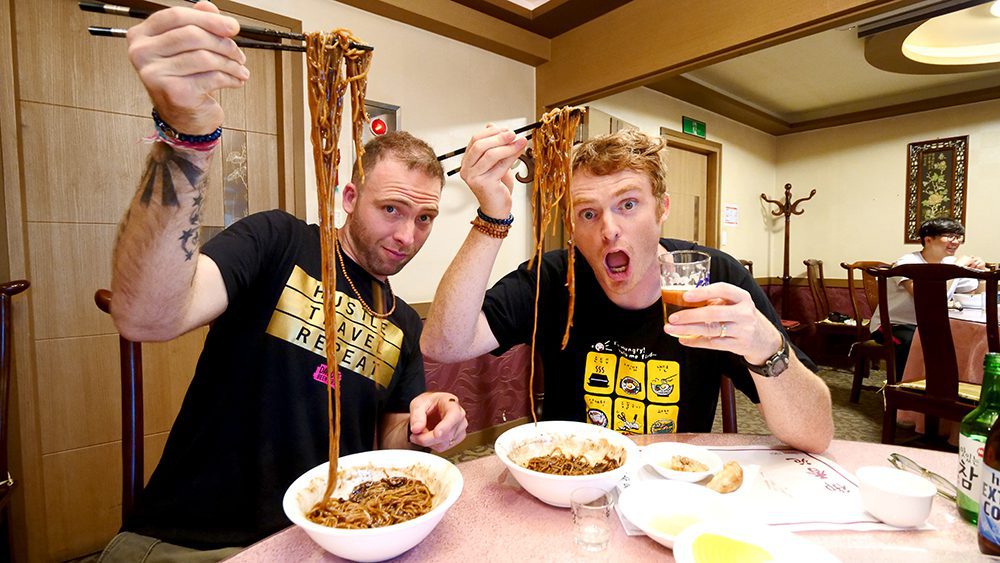
One such dish is the jajangmyeong, which is a Korean Chinese noodle dish that comes in a sauce made with black bean paste. It’s greasy, rich, and flavorful and is easily one of the heaviest dishes I ate in South Korea. I loved the hearty pieces of pork mixed throughout and the pork fat!

One of my favorite Korean dishes you must eat at Eohyang-Won Restaurant is tangsuyuk, a type of fried, chewy, crispy breaded pork that is bathed in a thick sweet and sour sauce. Mixed in with the pork and sauce are savory carrots and onions, as well as sweet pineapple!
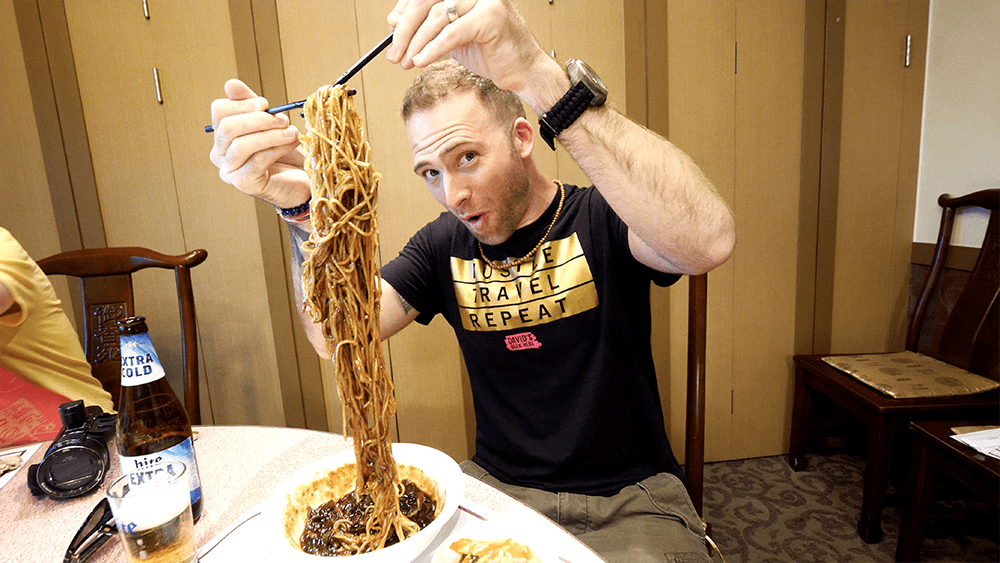
You also should not leave without trying the gun-mandu, which are delicious, pork-filled dumplings that are served in a black sauce. The sauce adds new levels of flavor and is nothing short of exceptional!

Like the Korean Chinese Food entry, this entry is more about an overall food experience than one or two specific Korean dishes you must eat. But trust me, you’ll understand why when you visit BIFF Square, which is known worldwide as the home of the Busan International Film Festival.
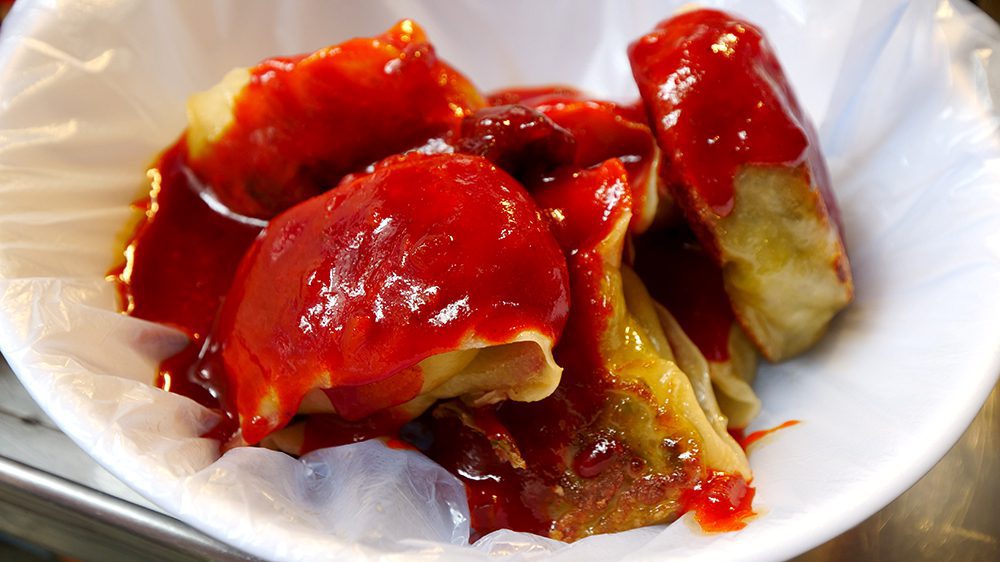
What many may not know is that BIFF Square is also home to lots of street food vendors who offer a wide variety of delicious and unique Korean treats. They include the ever-present tteok-bokki, which you can try along with a spongy fish cake called odeng. Don’t miss out on the meaty blood sausage called sundae, which is one of my favorites.
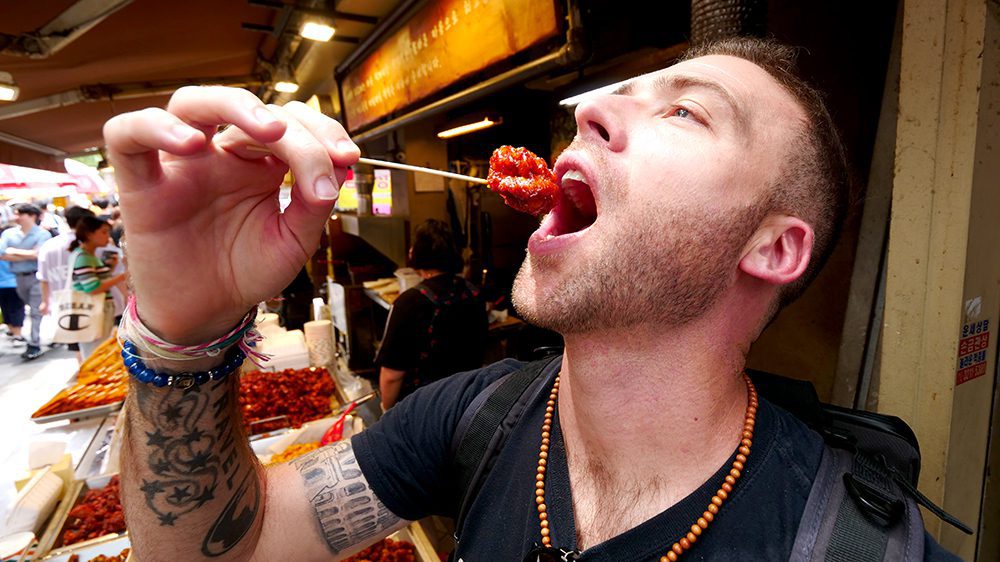
I mentioned dakgangjeong earlier, but it’s worth a second shout-out here because it truly is some of the freshest and most flavorful fried chicken in the world. You can also try some wonderful vegetable mandu, as well as garibi. Garibi is a smoky, grilled scallop that’s topped with corn, onion, sauce, and torched cheese. It’s every bit as delicious as it sounds!
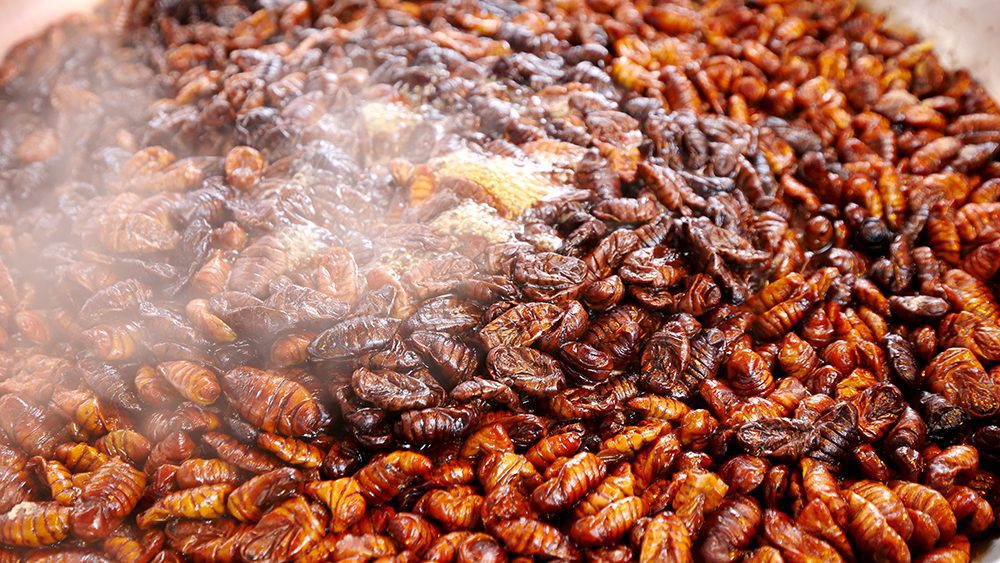
There’s also a silkworm larvae called beondegi, which seriously tested my gag reflex, and a giant, roasted marshmallows filled with ice cream that was pillowy and super sweet. I also enjoyed the waffle balls with bean curd inside, which was quite tasty!
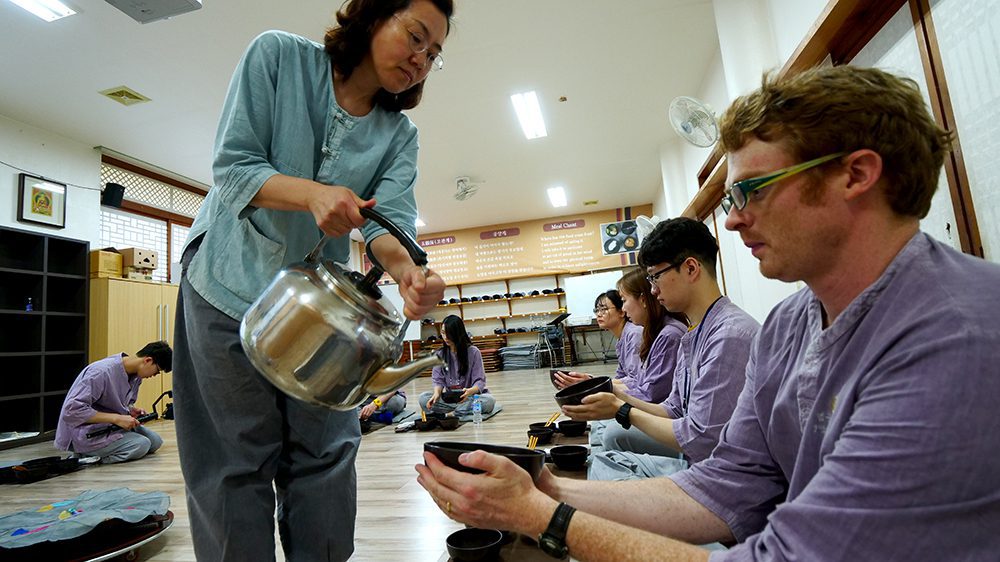
Earlier, I talked about Korean Buddhist monastic food in a restaurant setting. But if you want the true, immersive experience, you should try it during a temple stay. There are at least 30 temples in South Korea that offer overnight stays, but the one I stayed at was Beomeosa Temple in Busan. There, you’ll enjoy two fantastic, traditional meals.

Pay attention to the monks as they explain mealtimes to you. Be respectful and learn the proper way to eat. Don’t take more than you can eat because you have to finish it all. Nothing goes to waste here. Dinner consisted of a bowl of white rice and a delicious seaweed soup. You eat by holding the bowl as close to your face as possible and eating discreetly, so no one should be able to see you taking bites. You also can’t talk during your meal. Once you’re finished, you can put your bowl down.

A buffet-style breakfast is served the following morning. There, you’ll find rice, some delightfully spicy kimchi, and some crunchy and earthy seaweed. Your final “meal” during an overnight stay will consist of an orange and some tea during the da-seon, or tea ceremony, not long after breakfast. The food may sound simple, but it’s quite delicious. No Korean vacation is complete without these Korean dishes you must eat!

In South Korea, a full-course meal is called a hangjeongsik. To enjoy a royal Korean hangjeonsik, you should head over to Bansang Restaurant. The restaurant opens at noon, just in time for lunch.
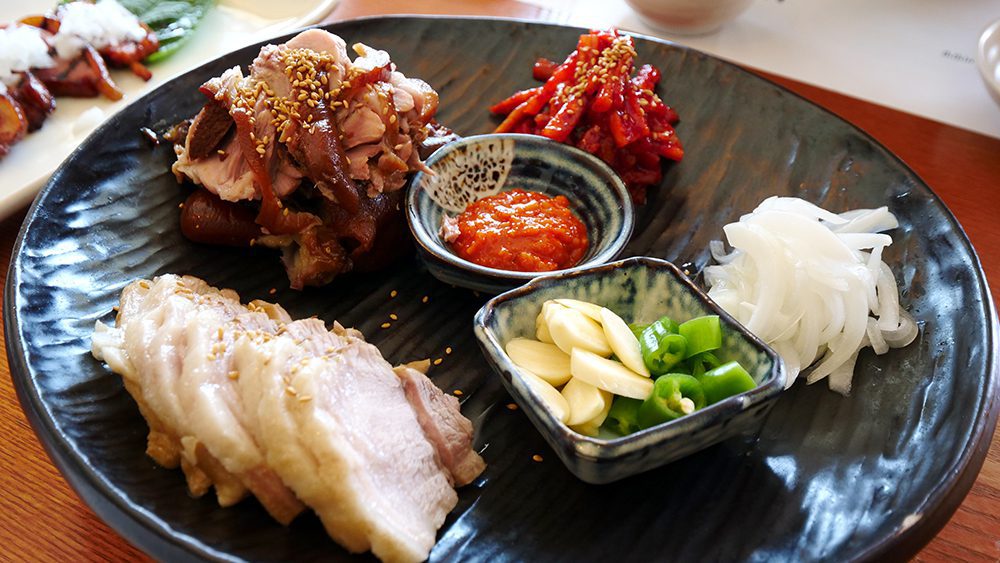
One of my favorite dishes of the hangjeonsik was the fatty and gamy duck in the very first course, which also includes a salad and a bland bean curd. You’ll follow that with pork with onions and chilies, teriyaki pumpkin, and some fantastic sweet potato glass noodles. Take the time to enjoy the marinated beef, which is unreal and has a hint of sweetness.
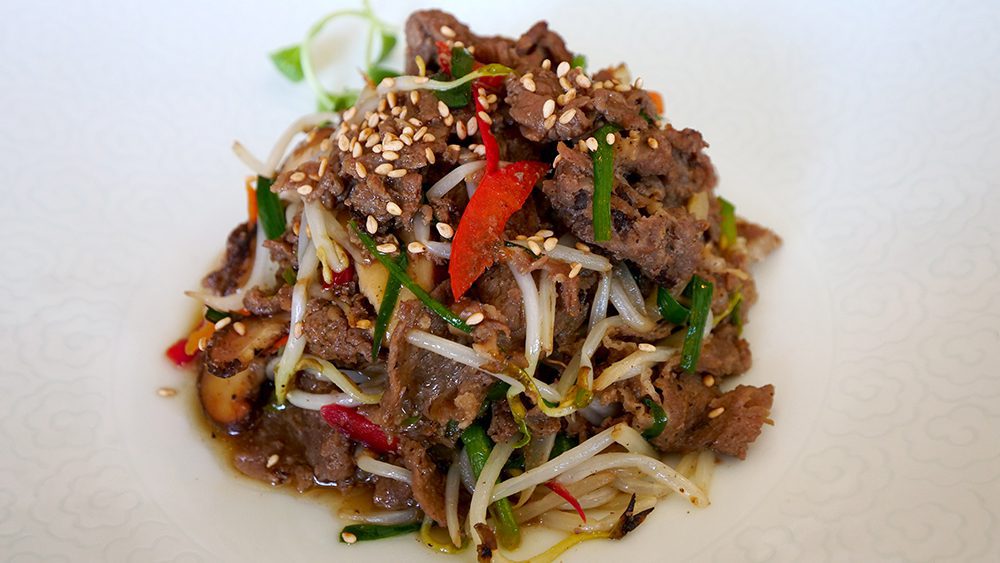
I also loved the fermented soybean and tofu soup with crab, the wild mushrooms, and the spicy kimchi. Finish your meal with a delicious black raspberry wine called Bokbunjajoo, which reminded me of rakia. There’s also a fantastic plum wine, so go all out with it! It’s a fabulous meal that’s full of Korean dishes you must eat and some tasty drinks I think you’ll really enjoy!

If you want a large and inexpensive spread of food in Korea, you should go with a bapsang. A bapsang is a large meal that centers around meat, vegetables, soups, and sides. Head over to the 24-hour Sigol Bapsang Busan Restaurant to enjoy one at any time of the day or night.
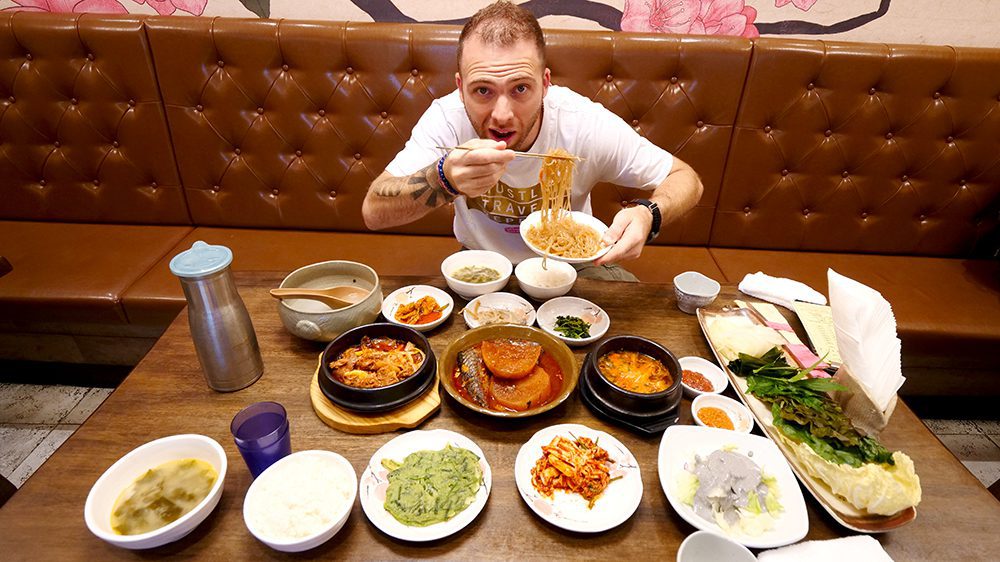
My unbelievable 14-dish spread centered around a spicy, stir-fried pork in gochujang sauce called jeyuk-bokkeum, fish with squash, and sundubu jjigae. You eat the jeyuk-bokkeum by wrapping it in lettuce and taking it all in one bite.
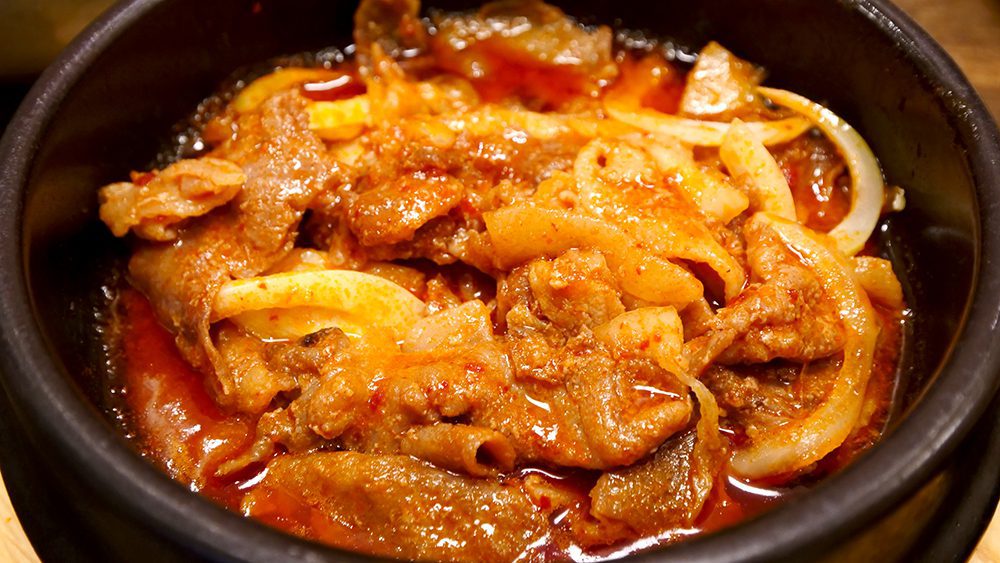
Don’t fill up on the main dishes, though, because the sides are just as amazing. An unexpected highlight was the salad I had, which had a black sesame dressing drizzled over it. The dressing had an almost chocolatey flavor that confused and delighted my taste buds. I also loved the savory pajeon, which is a pancake containing spring onion. The greasy glass noodles called japchae were really nice, as were the fish cakes. I love anything containing seaweed, so I loved the briny seaweed soup called miyeok-guk. I also enjoyed some fantastic root vegetables, mushrooms, and kimchi!
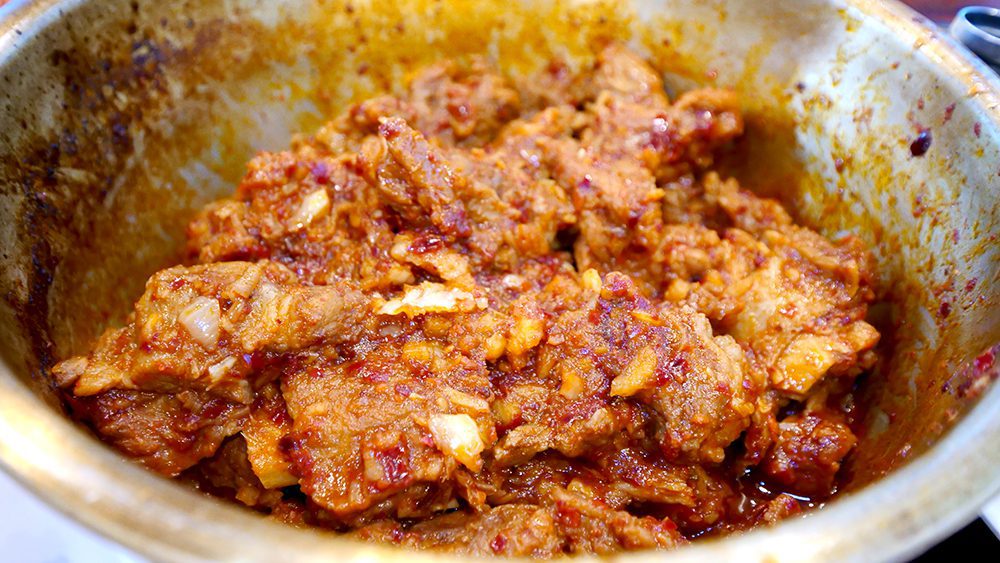
South Korea is a land of thousands of gastronomical options that range from traditional to modern. One of the more modern creations is galbi jjim, a braised beef short rib dish that was invented in Daegu in the 1970s. Head over to the Galbi Jjim Street in the Dongin-Dong area to try it out!
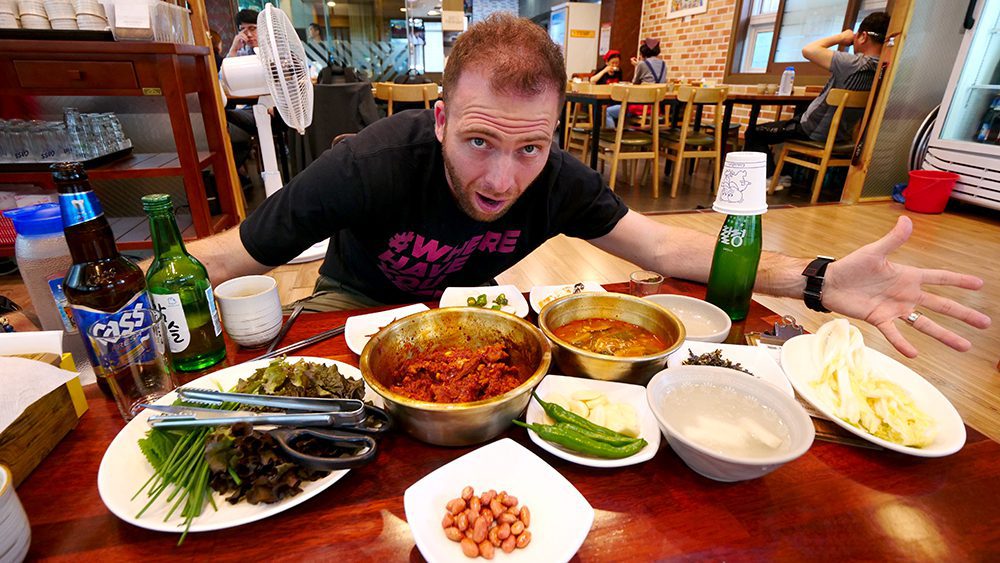
Along the street, you’ll find a remarkable restaurant called Bongsan Jjimgalbi. Their ribs are so tender that the meat falls right off the bone. It’s also incredibly juicy and contains a spice that also has a hint of sweetness to it. It makes your tongue and lips tingle in a way I’d never experienced! The galbi jjim there is the best beef ribs I’ve ever eaten, hands down. Whether you try it by itself or wrap it in a lettuce leaf, it’s not hard to see why it’s among the Korean dishes you must eat.

One of my favorite spots in Daegu to explore was Seomun Market. There were quite a few interesting dishes there, but I really want to highlight the hodu-gwaja, which is a ball-shaped pastry made from waffle batter. Inside is a walnut and generous amount of sweet red bean paste.

While sweets aren’t normally my thing, I can get behind red bean paste! The paste is smooth and goes really well with the nuttiness of the walnut and the crispy, sweet waffle batter. You can get 10 hodu-gwaja for just 3,000 won, or a little under $2.50 USD, so it’s a nice, inexpensive snack that you can take with you on the go!
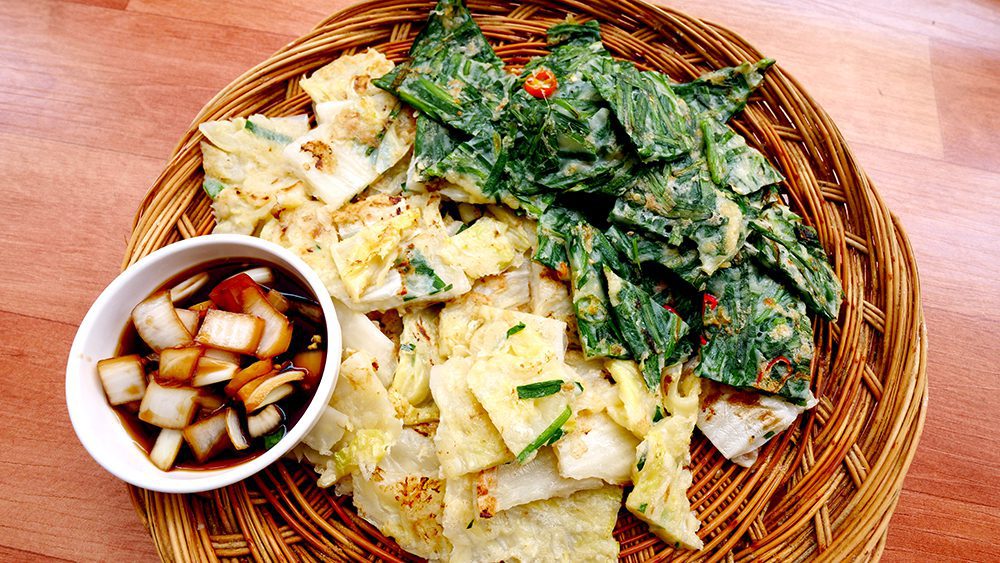
While you’re at Seomun Market, see if you can hunt down the savory pancake called buchu-jeon. This fantastic pancake is made with chives, leeks, and chilies. It’s almost entirely made of vegetables, which is evident in its green color, and you can see every ingredient in it. There’s just enough batter to hold it all together, so there’s almost no filler.

Korean food is always at its best when there’s a bit of spice, and the chilies inside it provide just the right amount. The chives and leeks were fantastic on their own, but when you combine them with the provided soy-and-onion sauce, it’s downright heavenly! If you love vegetables and pancakes, buchu-jeon is easily one of the Korean dishes you must eat!

While Korean food is often thought of as having just one characteristic, heat, it’s so much more than that. The sheer variety in the meats alone blew my mind, not to mention all the fresh vegetables that are used in every meal. Once you add in traditional dishes and more modern and unique creations, you realize that Korean food is just as varied as any other cuisine and that it may just be even tastier than most. Take a trip to South Korea today to taste it all for yourself!
NOTE: If you need to check the visa requirements of a particular country, click here. To apply for a visa, find up-to-date visa information for different countries, and calculate the cost of a particular visa, click here!
Counter
101 Countries • 1432 Cities